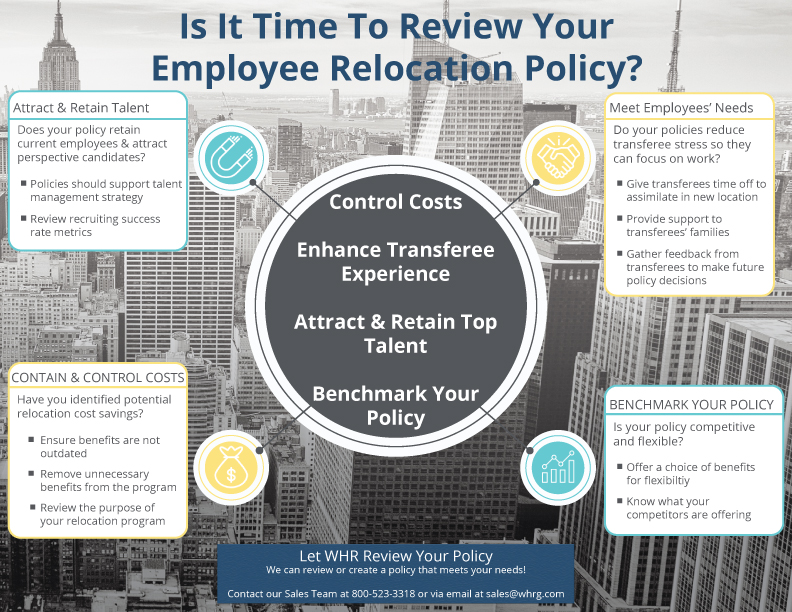In Anbetracht der vielen Änderungen, die sich für Unternehmen durch COVID-19 ergeben haben, darunter auch für Mitarbeiter, die aus der Ferne arbeiten, könnten Sie denken, dass es keinen Grund gibt, die Umzugsrichtlinien Ihres Unternehmens gerade jetzt zu überarbeiten. Aber denken Sie noch einmal darüber nach. Viele Unternehmen versetzen immer noch Mitarbeiter, um benötigte Stellen zu besetzen. Wenn Sie Ihre Richtlinien überprüfen und die erforderlichen Anpassungen jetzt vornehmen, kann dies Ihrem Unternehmen in den folgenden Bereichen helfen:
- Kontrolle der Unternehmenskosten
- Sicherstellen, dass Sie den Bedürfnissen Ihrer Mitarbeiter gerecht werden
- Top-Talente anziehen und binden
- Benchmarking Ihre Politik im Vergleich zum Wettbewerb
Die folgenden Beispiele stammen aus Überprüfungen der Richtlinien, die WHR Global für seine Kunden durchgeführt hat. Diese Beispiele zeigen, wie wichtig es ist, Ihre Versetzungspolitik regelmäßig zu überprüfen.
A. Kontrolle der Unternehmenskosten und keine Zahlungen für unnötige Leistungen
Vergewissern Sie sich, dass Sie den richtigen Betrag sowohl für die Mitarbeiter als auch für die Bedürfnisse des Unternehmens bereitstellen. Außerdem ist es wichtig, dass Sie nicht für unnötige oder überholte Leistungen zahlen.
- Beispiel Nr. 1
EinUnternehmen, dessen Politik wir überprüften, gewährte jedem Versetzungsempfänger eine standardmäßige Umzugspauschale in Höhe von 5.000 bis 10.000 $, um zusätzliche Kosten zu decken. Zusätzlich zu der Pauschale von 5.000 bis 10.000 Dollar erhielten die Führungskräfte einen Pauschalbetrag in Höhe von 6 Wochengehältern. Da einige Führungskräfte hohe Gehälter bezogen, belief sich diese Pauschale manchmal auf 50.000 $ pro Führungskraft! Nach einer Überprüfung empfahlen wir dem Unternehmen, diese Praxis für die Führungskräfte einzuschränken. Das Unternehmen sparte dadurch Hunderttausende von Dollar. - Beispiel Nr. 2
Ein Kunde zahlte einen Lebenshaltungskostenausgleich, wenn der Arbeitnehmer in ein teureres Gebiet umzog. Er zahlte dies 3-4 Jahre lang und gewährte außerdem einen hohen Pauschalbetrag. Wir empfahlen eine Mindestgrenze von 5 % für die Lebenshaltungskosten, damit sie keine Zahlungen an Mitarbeiter leisten mussten, die in Gebiete mit nur geringfügig höheren Lebenshaltungskosten umzogen. Der Kunde sparte Millionen. - Beispiel Nr. 3
Ein anderer Kunde gab Prämien ohne Beförderung an derzeitige Mitarbeiter aus, die bereit waren, für eine Querschnittsfunktion umzuziehen. Diese Prämien beliefen sich auf 5 % des Gehalts der Mitarbeiter. Da diese Praxis nicht üblich ist, empfahlen wir, dies aus der Versetzungspolitik zu streichen, was dem Unternehmen erhebliche Kosten ersparte, ohne den Wert des Programms zu schmälern. - Beispiel Nr. 4
Einer unserer Kunden zahlte eine Kreditvergabegebühr. Manche Kreditgeber erheben diese Gebühr gar nicht, aber wenn sie wissen, dass der Kunde sie zahlen wird, berechnen sie sie trotzdem. Als der Kunde dies erkannte, zahlte er die Gebühr nur noch, wenn es nötig war.
B. Erfüllen Sie die Bedürfnisse Ihrer Mitarbeiter
Es ist wichtig, dass Ihre Versetzungspolitik den Bedürfnissen Ihrer Mitarbeiter entspricht. Dies trägt dazu bei, den Stress der Mitarbeiter zu reduzieren, damit sie sich auf ihre Arbeit am neuen Standort konzentrieren können. Die Gewährung von Freistellungen zur Eingewöhnung am neuen Standort, die Unterstützung der Familienangehörigen und die Einholung von Feedback nach der Versetzung, um künftige Entscheidungen treffen zu können, tragen dazu bei, die Bedürfnisse Ihrer Mitarbeiter zu erfüllen.
- Beispiel Nr. 1
Einer unserer Kunden bot einen Pauschalbetrag für alle internationalen Umzüge an. Durch eine Umfrage nach dem Umzug fanden wir heraus, dass die Umziehenden versuchten, ihre eigenen internationalen Haushaltsgütertransporte zu koordinieren und nicht den vollen Pauschalbetrag ausgaben, in der Hoffnung, etwas Geld zu behalten. Aus den Rückmeldungen ging auch hervor, dass es für die Mitarbeiter mehr Stress bedeutete, wenn sie die Wahl hatten, und dass der Umzugsprozess dadurch länger dauerte. Im Grunde versuchten die Umziehenden, alles auf eigene Faust zu machen und dabei auch noch Geld zu sparen. Der Kunde zog alle wichtigen Vorteile in Betracht und stellte fest, dass der Pauschalbetrag nicht funktionierte. Er ging von einem Pauschalbetrag zu einer flexiblen Kernleistung über. Das bedeutete, dass der Kunde die Kosten für den HHG-Versand, die Dienstleister am Bestimmungsort und die vorübergehende Unterbringung übernahm, aber den Mitarbeitern weiterhin einen Pauschalbetrag gewährte, den sie nach eigenem Ermessen verwenden konnten. Dies trug nicht nur dazu bei, den Stress der Umziehenden zu verringern, sondern auch die Geschäftskosten zu kontrollieren.
- Beispiel Nr. 2
Ein Kunde bot Ehegatten/Partnern und Familien bei innereuropäischen Umzügen keine Zielgebietsdienste an. Er ging davon aus, dass ein Transferee/eine Familie, der/die z. B. von Russland nach Großbritannien umzieht, keine Zielgebietsdienste benötigt. Aus der Umfrage nach dem Umzug ging hervor, dass die Ehegatten/Partner berufliche Unterstützung, Sprachunterricht und Hilfe bei der Schulsuche für ihre Kinder benötigten. Die Angestellten verfügten über Büroangestellte, die ihnen bei der Eingewöhnung an den neuen Standorten halfen, aber die Partner der Umziehenden hatten mit der neuen Sprache zu kämpfen und hatten sogar Schwierigkeiten, notwendige Dinge wie Lebensmittelgeschäfte zu finden. Für einen erfolgreichen Umzug und eine erfolgreiche Integration ist es von entscheidender Bedeutung, dass die Bedürfnisse der gesamten Familie und nicht nur die des Umzugsteilnehmers berücksichtigt werden.
C.Gewinnung/Bindung von Talenten und Benchmarking Ihrer Politik im Vergleich zur Konkurrenz
Hoffentlich ist Ihre Versetzungspolitik bereits Teil Ihrer Gesamtstrategie für Vergütungen und Talentmanagement. Die richtige Politik wird Ihrem Unternehmen helfen, aktuelle Mitarbeiter zu halten und potenzielle Bewerber anzuziehen. Eine schwache Versetzungspolitik könnte sich negativ auf Ihre Erfolgsquote bei der Personalbeschaffung auswirken.
Ein Vergleich mit anderen Unternehmen hilft Ihnen, im Kampf um Talente wettbewerbsfähig zu bleiben. Vergewissern Sie sich, dass Ihre Politik eine Auswahl an Angeboten bietet, da Umzugsmaßnahmen in Stellenangeboten enthalten sind. Wenn Sie keine Vergleiche mit Ihren Konkurrenten anstellen, werden Sie nicht wissen, ob Ihre Angebote gut sind oder nicht. Sind sie unterdurchschnittlich im Vergleich zu dem, was alle anderen anbieten? Wenn Sie z. B. hochrangige Führungskräfte einstellen und es sich um sehr spezielle und schwer zu findende Talente handelt, sollten Sie sicherstellen, dass Sie bei Gehalt, Sozialleistungen und Umzugsbedingungen wettbewerbsfähig sind.
Gleichzeitig stellt das Benchmarking sicher, dass Sie nicht zu viel verschenken, wenn keiner Ihrer Konkurrenten dies tut. Ein Benchmarking Ihrer Politik mit anderen zeigt, dass Sie im Einklang mit der Branche stehen. Es ist auch wichtig, nicht nur Ihre Branche zu betrachten, sondern auch andere Branchen, mit denen Sie um Talente konkurrieren.
- Beispiel Nr. 1
Stellen Sie sich vor, Sie verlieren einen potenziellen Bewerber, weil Ihre Umzugsrichtlinie keine Leistungen enthält, die Ihre Konkurrenten anbieten. Wenn es sich bei Ihrem Kandidaten beispielsweise um eine Führungskraft handelt, die ein komplettes Buyout erwartet, Ihre Police aber nur einen HHG-Umzug und eine Pauschalabfindung vorsieht, müssen Sie mit Ihren Vorgesetzten und dem Kandidaten hin und her verhandeln. Das kann sehr viel Zeit kosten. In der Zwischenzeit könnte der Kandidat ein besseres Stellenangebot erhalten, das mehr Umzugsbeihilfen beinhaltet. Die Umzugsbedingungen können ein Faktor sein, der Bewerbern die Entscheidung erleichtert, ob sie eine Stelle annehmen oder eine andere. Wenn Sie Ihre Politik mit der Ihrer Konkurrenten verglichen haben, wissen Sie bereits, was deren Politik beinhaltet.
- Beispiel #2
EinKunde erhielt von seinem Talentakquisitionsteam die Rückmeldung, dass es schwierig sei, bestimmte Stellen zu besetzen. Nachdem wir die Richtlinien des Unternehmens überprüft und mit denen der Konkurrenz verglichen hatten, stellten wir fest, dass die Konkurrenz weitaus umfangreichere Umzugszuschüsse bot. Daraufhin beschloss das Unternehmen, das Angebot an Stellen, für die volle Umzugszuschüsse gewährt werden, zu erweitern.
D. Wie oft sollten Sie Ihre Politik überprüfen?
WHR empfiehlt Ihnen, Ihre Umzugsrichtlinien jährlich oder spätestens alle paar Jahre zu überprüfen. Es muss keine große Überarbeitung sein, aber es ist eine Chance für Sie, innezuhalten und das Feedback der Mitarbeiter zu berücksichtigen. Darüber hinaus sollten Sie alle Veränderungen in Ihrer Unternehmenskultur, Ihren Leitprinzipien, Ihren Grundwerten, Ihrer Talentstrategie, der Branche und Ihrer Konkurrenz überprüfen. Bei der Überprüfung können Sie sicherstellen, dass Ihre Richtlinien mit all diesen Elementen und Ihren wichtigsten Stakeholdern (Talentakquisitionsteams, Rekrutierungsteams, HR-Geschäftspartner) in Einklang stehen.


